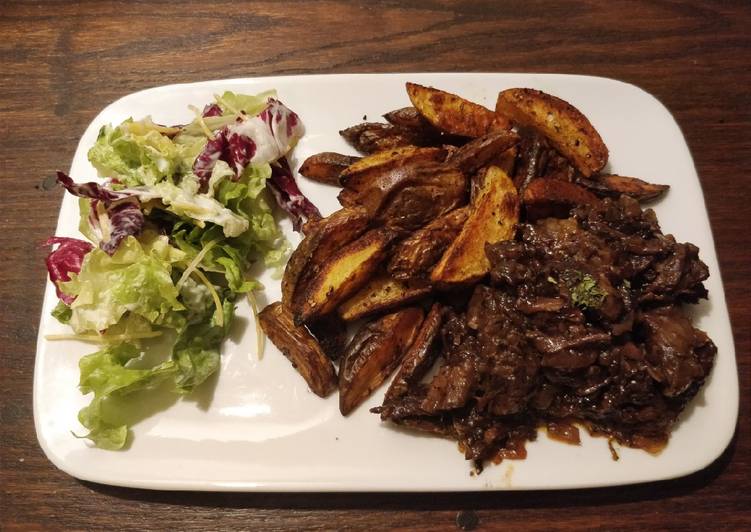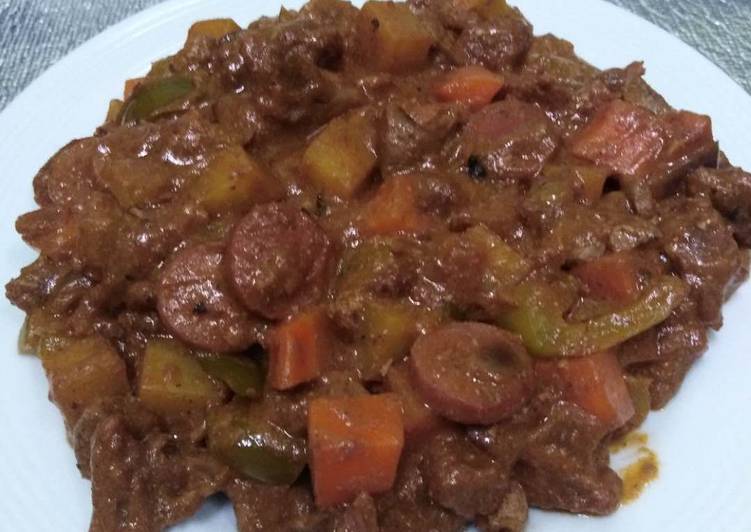
Hello everybody, it is Drew, welcome to our recipe page. Today, I’m gonna show you how to make a distinctive dish, 'indonesian' beef stew. One of my favorites. For mine, I’m gonna make it a bit unique. This will be really delicious.
'Indonesian' beef stew is one of the most popular of current trending foods in the world. It is appreciated by millions daily. It’s easy, it’s quick, it tastes delicious. They’re nice and they look wonderful. 'Indonesian' beef stew is something which I’ve loved my entire life.
Empal gentong beef stew recipe can be cooked by yourself. Complete with explanations simple and easy to understand. This meal is from Cirebon, West Java. Rendang Daging is beef stewed in coconut milk with spices until all of the coconut milk has been Indonesian food is quite popular in the Netherlands for historic reasons, and Rendang is one of the.
To begin with this recipe, we have to prepare a few components. You can have 'indonesian' beef stew using 12 ingredients and 12 steps. Here is how you can achieve that.
The ingredients needed to make 'Indonesian' beef stew:
- Make ready 2 small onions
- Get 1 glove of garlic
- Prepare 2 tbs butter
- Prepare 400 g beef, rib or other stew cuts
- Get 100 ml red wine
- Prepare 100 ml water
- Make ready 5 tbs ketjap (or soy sauce)
- Make ready 3 thyme springs (or 1tbs dried thyme)
- Make ready 2 bayleafs
- Take 4 cloves
- Prepare 2 tbs tomato ketchup
- Prepare 1 tbs potato starch (or general binding agent)
This dish is for meat lovers. This is a family favorite and really hit the spot after romping around in the snow. Rendang is a traditional spicy beef dish popular in Malaysia, Indonesia and other parts of South East Asia. Chef Rich Harris shows you how to make it in this episode of Asian Bites.
Instructions to make 'Indonesian' beef stew:
- Roughly chop the onions and peel the garlic.
- Season the beef generously on both sides with salt and pepper.
- On medium heat melt some butter and start cooking the onions and the garlic. Use a garlic press, or mince the garlic.
- When the onions are halfway there, make room for the beef. You could do this in stages, but why bother…
- Brown the beef on both sides. Render out as much fat as you can.
- Pour the ketjap over the meat and give it a minute to boil and let it flavor the beef. Don't let it evaporate completely though. Don't worry if it is too much or too little, you can adjust for salt with the final seasoning.
- From the side of the pan, add the wine and the water. It should just cover the meat, depending on the size of the pan.
- Add the spices and the tomato ketchup and stir till combined.
- Cover and let simmer for at least 4 hours. Check every hour or so for liquid, and add water if it appears to become dry. Also turn the beef over to help even cooking. It may fall apart already, that is fine.
- After this time break up the beef into chunks of your desired size. And remove the thyme springs and bayleafs.
- Mix the potato starch with a teaspoon of cold water and mix it up, before stirring it through the stew. Taste and add salt and pepper to taste.
- Serve with fries, potatoes, rice or just plain. And don't forget to eat some vegetables as well.
Rendang is a traditional spicy beef dish popular in Malaysia, Indonesia and other parts of South East Asia. Chef Rich Harris shows you how to make it in this episode of Asian Bites. Keressen Indonesian Beef Stew On Black Bowl témájú HD stockfotóink és több millió jogdíjmentes fotó, illusztráció és vektorkép között a Shutterstock gyűjteményében. Beef Rendang - the best and authentic beef rendang recipe online! Spicy and rich Malaysian/Indonesian beef stew made with beef, spices and coconut milk.
So that’s going to wrap this up with this exceptional food 'indonesian' beef stew recipe. Thanks so much for your time. I’m confident you can make this at home. There’s gonna be more interesting food in home recipes coming up. Remember to save this page on your browser, and share it to your loved ones, colleague and friends. Thanks again for reading. Go on get cooking!

